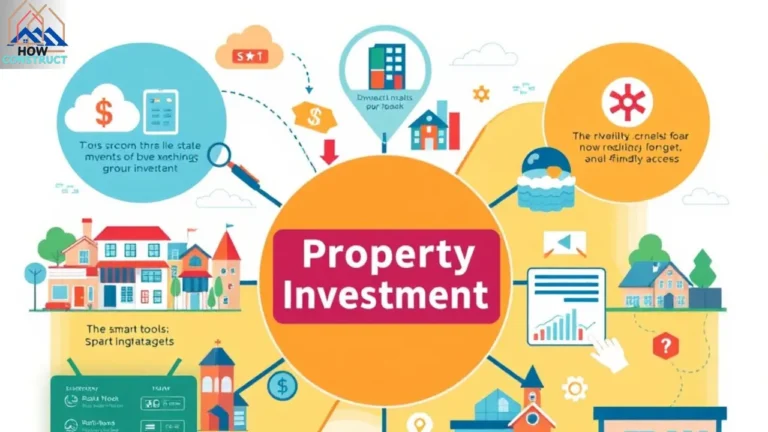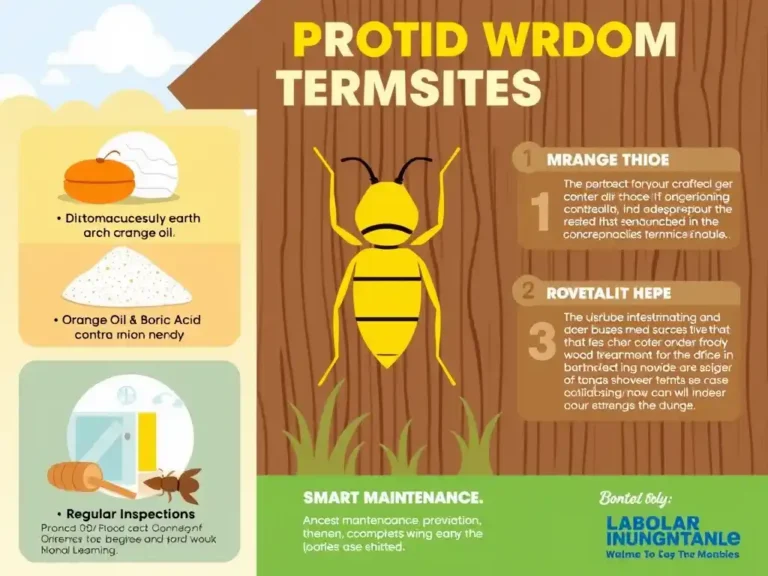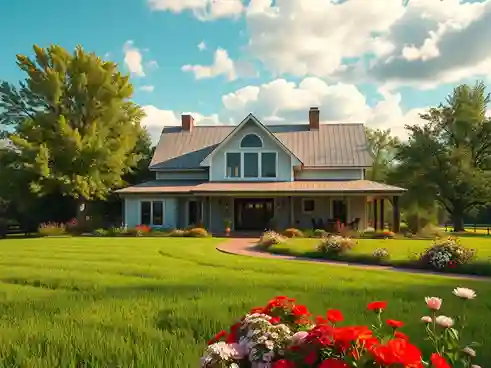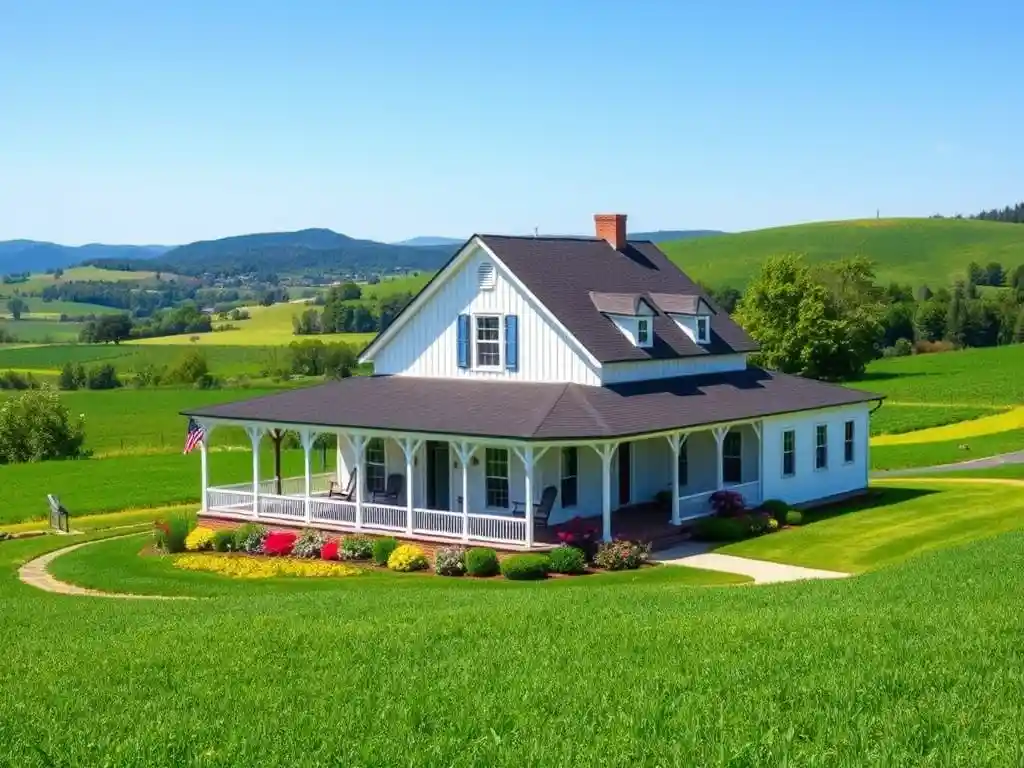As technology goes on growing, the integration of smart home features into farmhouses is manipulating the style we live and work in rural areas. It has been known to every farm house lover that how some of the key features of farm house are to be introduced to enlighten their usage and comfort.
1. Introduction
The modern farmhouse trends are changing. It have been evolving their functionality, inviting culture, aesthetic. Some sort of facilities have to be incorporated to them. The modern Farm House are different from the old-age rural settings in terms of their sustainability, smart technology, security and adoptability. The visitor are stuck in the modern architecture, beautiful landscape and cozy environment. The smart patio, walkways, set of gaming facilities, cages of animals, allied swimming facilities and many more, are the key attractive parameters which sets them different than the old styles. Here are some of the following features for the construction point of view regarding farm house
Innovations in Smart Farmhouse Technology
The modern farm house has been provided with Smart lighting systems, which can be managed remotely via smartphones or voice-activated devices like Amazon Alexa or Google Assistant. They can be automated to turn on or off based on activity or specific uses.
Example: Imagine coming home to a well-lit farmhouse after a long day on the fields. Smart lights can automatically illuminate pathways and rooms when they detect movement, providing safety and ease. Additionally, homeowners can adjust the brightness and color temperature to create a cozy atmosphere for family gatherings.
Pros:
Energy Efficiency: Smart bulbs consume less energy and can significantly lower electricity bills. Enhanced Security: Automated lighting can deter intruders by mimicking occupancy, even when homeowners are away.
Cons:
Setup Costs: Initial setup cost may be substantial and quite on upper side especially when retrofitting older homes.
Wi-Fi Dependence: If the internet connection breaks up, the smart technology system will be leaving the farm owner in dark.
Climate Control Systems
Description: Smart thermostats like Eco bee or Nest foster user habits and preferences, adjusting heating and cooling automatically to optimize comfort and energy use.
Example: A user who generally leaves for early morning tasks can fix the thermostat to begin warming the house just before their return. This feature ensures a comfortable environment without wasting energy while the house is empty.
Pros:
Energy Savings: Users can save up to 15% on heating and cooling expenditure through optimized settings.
Remote Access: Owner can manage settings from anywhere, ensuring their home is comfortable upon arrival.
Cons:
Compatibility Issues: The running old HVAC systems may require repair and maintenance or may not work seamlessly with new smart thermostats.
Privacy Concerns: These systems gathers data on user behavior, which may be some time unfriendly.
- Smart Equipment
Smart appliances or equipment vary from refrigerators that can produce the shopping lists to washing machines which can be monitored remotely via smart phone or other devices.
Example: A smart refrigerator, like those from Samsung, can read expiry dates and predict recipes based on available ingredients. This feature decreases food waste and helps streamline meal preparation.
Pros:
Convenience: Users can control their kitchen and laundry, making life comfortable during busy working hours remotely.
Energy Efficiency: Some smart appliances are manufactured to use less water and energy. it will be effectuating to lower utility bills.
Cons:
High Initial Costs: Smart appliances may come up with a good price tag compared to traditional models. Technical Issues: Software interrupts or connectivity problems can abate functionality and require troubleshooting.
Security and Vigilance Systems
Smart security systems comprises of alarms, movements detectors, and security cameras. These can be monitored through smart phones.
Example: A user who may receive a real-time alert on his smartphone when anybody reaches his property, allowing him to consider the situation and respond immediately, whether he is at home or away.
Pros:
Real-Time Monitoring: users can verify his camera reals and can receive alerts about unusual activity, increasing security.
Integration with Other Systems: Smart security system if clubbed, with smart lighting system, may be locking the increased cyber threats
Cons:
Hacking Risks: Such systems if not maintained properly, can be attacked by the cyber hackers. It can foste a risk to personal privacy and security.
Ongoing Costs: Many smart security systems need monthly emoluments for full operations, moving to long-term expenses.
- Water Management Systems
Smart irrigation systems are design to calculate the field watering capacity of each plant, and can check the moisture in the plant roots. It can efficiently manages the exact watering requirements of the crops. Further, it will automatically control the flow of water in the sprinkling or drip irrigation systems.
Example: A smart irrigation controller can manage watering times based on rainfall forecasts, preventing overwatering and conserving water resources—essential for sustainable farming practices.
Pros:
Water Conservation: These systems can immensely reduce water requirements, helping farmers to cut short the costs and promote sustainability.
Healthier Plants: Precision and efficiency mechanism in watering ensures that plants receive optimal hydration, improving crop yields.
Cons:
Installation Complexity: Setting up a smart irrigation system may need professional resource, which can enhance its costs.
Technical Challenges: Farmers may need to invest time in learning how to use and maintain these systems effectively.
3. Pros and Cons of Smart Technology in Farmhouses
Pros
Enhanced Efficiency: Smart technologies minimize their resource input, leading to lower electricity bills and reduced environmental implication. For example, using smart thermostats and appliances collectively can do significant energy savings.
Increased Comfort: Users can produce a competitive living environment. For instance, smart lighting can control automatically based on natural light levels, maintaining a suitable atmosphere throughout the whole day.
Convenience and Control: With these security systems, a user can manage his farm house utilities remotely via smart technology through smart phones
Improved Security: With the help of the smart technology the farm house and remote areas are less vulnerable to security threats and unusual situation, making rural homes less vulnerable to intrusions.
Cons
Cost: The initial investment in smart technology can be substantial. Homeowners must measure the potential savings against advance expenditures.
Complexity: Integrating of a variety of smart security system may be complex. Some users may find themselves overwhelmed by the technology, leading to frustration.
Dependence on Technology: Relying on smart systems means that disruptions or technical issues can disturb daily life. A power shutdown can disable smart systems, leaving homeowners without security or climate control.
Privacy Concerns: Increased connectivity fosters implications and concerns about data security. User must be vigilant in overseeing their devices to protect personal information.
4. Conclusion
Integrating smart home technology into farmhouses introduces an incredible step forward in rural living. Innovations and the incorporation of smart technology systems in different aspects like lighting, climate control, appliances, security, and water management are enhancing the quality of life for Farmhouse owners while promoting sustainability and efficiency. However, it’s pertinent to mention the pros and cons of these technologies, particularly regarding cost, complexity, and privacy. As we embrace the future, smart farmhouses may become the new standard, merging the beauty of rural life with the conveniences of modern technology












